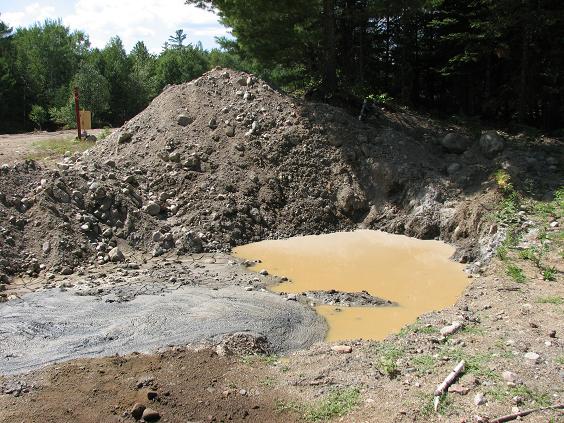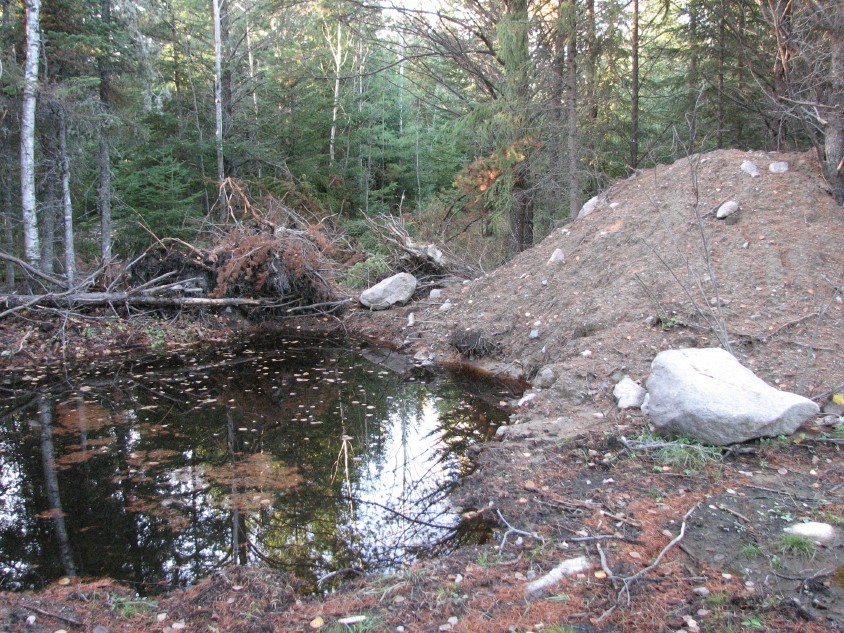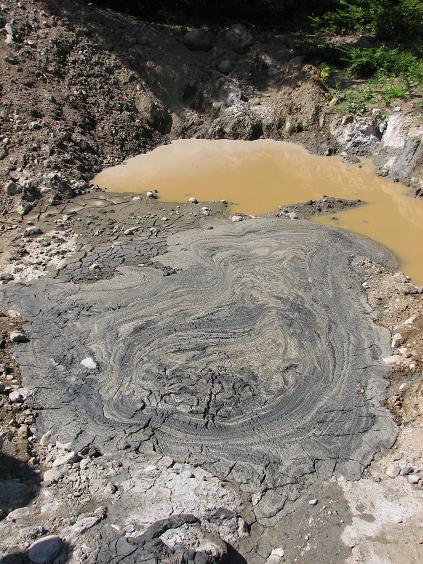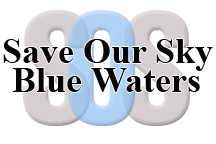***** This comment period has closed *****

Drill cuttings, including hydrocarbons, in overflowing sump pit from mineral exploration drill site.
Location: along the Kawishiwi River near the BWCAW, Superior National Forest, Lake County, Minnesota
Federal Hardrock Mineral Prospecting Permit Draft EIS (EIS)
Broadscale analysis to address FS consent and BLM issuance of federal hardrock mineral prospecting permits and operating plans (present and future). The Notice of Availability for the DEIS was published in the Federal Register on April 1, 2011.
NOTICE: The comment period has been extended to June 30, 2011.
The USFS is accepting comments on the Draft Environmental Impact Statement for the Federal Hardrock Mineral Prospecting Permits Project on the Superior National Forest, Minnesota.
Draft Environmental Impact Statement Found Here
Vicinity Map Found Here
State of Minnesota Active Lease Areas and Past DRill Sites Map Here
Mineral Interest Map Found Here
For more info- go to the USFS website linked Here
Written comments may also be submitted electronically to: comments-eastern-superior@fs.fed.us
or by fax to (218) 626-4396
Or directly to:
JAMES W. SANDERS, FOREST SUPERVISOR
SUPERIOR NATIONAL FOREST
8901 GRAND AVENUE PLACE
DULUTH MN 55808
From the DEIS cover Letter: Found Here
Dear Sir or Madam:
We have completed the Draft Environmental Impact Statement (EIS) for the Federal Hardrock Minerals
Prospecting Permits Project (Project), located Forest-wide on the Superior National Forest (SNF). A
copy of the Draft EIS document, maps, operating plans and prospecting permit applications submitted by
the mineral companies are available on the SNF website: www.fs.usda.gov/goto/superior/projects, then
scroll down to “Federal Hardrock Minerals Prospecting Permit EIS”.
I am interested in your comments on the Draft EIS. Your comments regarding the proposed action and its
alternatives will be extremely helpful in assisting me in finalizing the analysis and in making my decision.
Overview
The U.S. Bureau of Land Management (BLM) has received applications to conduct hardrock mineral
exploration activities including drilling and geophysical surveys on federally owned minerals on the SNF.
The BLM is the federal agency that manages federal hardrock minerals on the SNF. The Forest Service is
the surface management agency and therefore the lead agency for the environmental analysis. The SNF
must decide whether to provide consent to the BLM to authorize the prospecting permits and operating
plans; and if the agency consents, the operating stipulations under which those permits and plans may
operate. The Draft EIS for the Project analyzes the potential effects of applications currently under
consideration and the potential effects of mineral prospecting activity anticipated over the next twenty
years. A more detailed summary of the project can be found in the first section of the Draft EIS.
Preferred Alternative
I have identified Alternative 4 as the preferred alternative, based on how well this alternative addresses
issues regarding potential impacts to the forest sound resources while still meeting the purpose and need.
How to Provide Comments
Federal regulations require your comments to be filed within 45 days from which the Draft EIS Notice of
Availability is published in the Federal Register. The publication date will be posted on the SNF web
page, but is anticipated to be April 1, 2011. Those who provide comments during this comment period
are eligible to appeal pursuant to 36 CFR 215 regulations.
No comments will be accepted after the comment period ends.
Comments must be sent to:
Written comments: Forest Supervisor
Attn: Federal Hardrock Minerals Prospecting Permits Project
Forest Supervisor
8901 Grand Avenue Place
Duluth, MN 55808
Faxed comments: Forest Supervisor
Subject: Federal Hardrock Minerals Prospecting Permits Project
FAX: (218) 626-4398
Email comments: To: comments-eastern-superior@fs.fed.us
Subject: Federal Hardrock Minerals Prospecting Permits Project
Acceptable formats for electronic comments are: text (.txt), MSWord
6.0 or higher (.doc), portable document format (.pdf), or rich text format
(.rtf). E-mail
Oral or hand-delivered comments: The office business hours for those submitting hand-delivered
comments are 8:00 am to 4:30 pm Monday through Friday, excluding holidays. Please provide
oral comments in person at the Forest Supervisor’s office during normal business hours or via
telephone to Loretta Cartner, Forest Geologist, at (218) 626-4382.
Please include the following in your comment response: (1) Name and address of the individual or
organization; (2) Title of the project; (3) Specific comments on the proposal, along with supporting
reasoning and; and (4) signature or other verification of identity on request. I ask that your comments be
as specific as possible. Comments received in response to this letter, including the names and addresses
of those who comment, are part of the public record for this action and are available for public inspection.
Comments that are specific to this project and include supporting rationale are most useful. If you wish to
reference scientific literature in your comments, send a copy of the entire reference cited, and include
your rationale as to how or why you feel it is pertinent to the project. This will allow me to fully evaluate
your comments.
Excerpted from the DEIS cover Letter: Found Here
*************************************************
Sierra Club's Federal Hardrock Mineral Prospecting Permit Draft EIS Comment Suggestions Here
*************************************************
Draft EIS Comment Suggestions:
To: James Sanders
Forest Supervisor
8901 Grand Avenue Place
Duluth, MN 55808
comments-eastern-superior@fs.fed.us
Public comment for the Federal Hardrock Prospecting Permits Project
I am writing in favor of the No Action Alternative for the following reasons:
The Federal Hardrock Prospecting Permits DEIS, as written, does not address the cumulative effects of road density patterns that will become established in Superior National Forest if all 33 permit applications are allowed.
Road openings into the interior of the forest, even if temporary (5-20 years), will impact wildlife habitat and wildlife corridors. This could include habitat of threatened/endangered species such as the moose, lynx, and wolf. Logging and dozing of roadways indicates that the individual footprints of each drill site carry the potential for impact on wildlife.
Road openings also open the forest to invasive plant species.
Noise considerations are not adequate. What is the impact of 24 hour a day drilling on wildlife? What is the potential for helicopter use? What is the over-all effect on bird species, migratory birds, amphibians and reptiles, as well as wildlife in various stages of raising young?
There are no adequate plans for mitigation of spillage, which could include petrochemicals and chemicals used in drill operations. Ground water analysis needs to convey potential for water contamination.
The DEIS does not address the potential for acid mine drainage when disturbing sulfide bearing rock.
The DEIS does not analyze each prospective permit site individually. Nor does the DEIS suggest that further environmental review be done for each site individually. Not only is the cumulative analysis incomplete, but individual site analysis is also missing. If requested permit operations have not been adequately evaluated, how is it possible to analyze additional permitting operations that are projected over the next twenty years?
Drill holes can be left open for the length of the permit, which can be six to ten years. Yet monitoring and reclamation is non-specific. How does this fit in with over-all Superior National Forest policy?
Some of the proposed exploration borders the BWCAW. Since these metals would not be used for strategic national interests—in fact the metals would be exported to our international competitors—any exploration adjacent to the BWCAW should be prohibited. Exploration is disturbing to both recreational users and wildlife. The DEIS lacks an economic analysis regarding potential losses to the tourism industry for the benefit of tenuous mineral exploration.
The USFS claims that it must allow all mineral exploration, according to law. But law also says that watersheds must be protected. The USFS has the power to deny exploration that would have negative impacts on forest use or be incompatible with forest plans. This document does not lay out a basis for denying individual permits from a cumulative perspective, which might include total impacts to adjoining wilderness, overall sensitivity of wetland environments, or over-all negative impacts due to accessing of remote areas within Superior National Forest. As such, this DEIS is not in compliance with its intended purpose.
All permitting should be halted until analysis can lay out both specific site analysis and total cumulative analysis of the burgeoning extent of mineral exploration that would, in its present form, destroy the character and quality of Superior National Forest.
Further, the Forest Supervisor should find that issuing the prospecting permits is not in the public interest, and the applications should be rejected.
*************************************************
Overflowing sump pits - Mineral Exploration along the Kawishiwi River near the BWCAW,
Superior National Forest, Lake County, Minnesota





